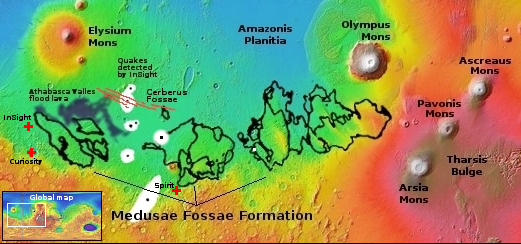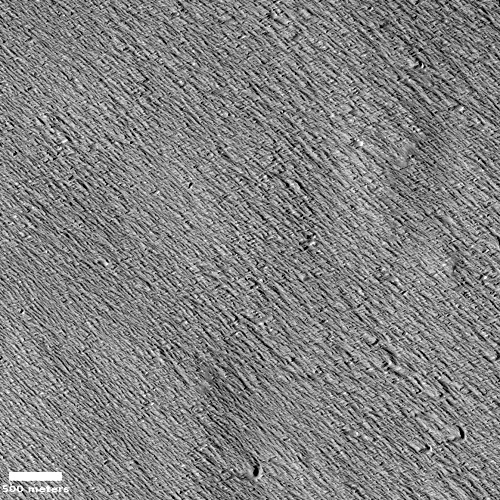The endless volcanic ash of Mars’ Medusae Fossae Formation
Cool image time! The picture to the right, cropped, reduced, and enhanced to post here, was taken on January 6, 2023 by the high resolution camera on Mars Reconnaissance Orbiter (MRO), and shows a small but typical area of the Medusae Fossae Formation, what is thought to be the largest volcanic ash deposit on Mars.
The picture itself was a “terrain sample,” taken by the MRO science team not as part of any specific research but to fill a gap in the camera’s schedule so as to maintain its temperature. The terrain itself looks like a field of sand that someone had run a fine comb across. In this case, the comb was the winds of Mars, prevailing from the southeast to the northwest. The crescent-like divots in the picture’s lower right are probably caused by some hard underground feature that the winds cannot blow away. Instead, it blows around, like water in rapids flowing around a rock, and takes the ash with it as it does so.

The white dot near the center of the overview map to the right marks this picture’s location, inside Medusae.
Scientists estimate the size of the entire Medusae ash deposit to be comparable to about the size of India and in some places as much as a thousand feet deep. They believe the ash is volcanic pyroclastic ash, material released quickly during a violent volcanic eruption such as the one that occurred at Mount St. Helens in 1980. Nor does all of the deposit have this endless combed look. Because the ash drapes the underlying topography, it sometimes shows hints of those underlying structures. And of course, the edges and gaps in the deposit result in more complex topography. See for example this July 2021 cool image only a few miles to the southwest of today’s picture. This endless plain of ash suddenly ends, as the ground drops down into a canyon.
The mystery is that this formation, while smack dab in the middle of volcano country surrounded by Mars’ biggest volcanoes, it is too far away from those volcanoes for the ash from their eruptions to have been blown here by the wind, based on our present understanding of Mars’ atmosphere. Scientists are therefore unsure how the ash got here. Though much of the terrain here, between these giant volcanoes, is flood lava laid down by nearby vents and not from the big mountainous volcanoes, such flood lava doesn’t produce explosive pyroclastic ash. Instead, this lava flows out from the vents more gently, steadily without explosive events.
On Christmas Eve 1968 three Americans became the first humans to visit another world. What they did to celebrate was unexpected and profound, and will be remembered throughout all human history. Genesis: the Story of Apollo 8, Robert Zimmerman's classic history of humanity's first journey to another world, tells that story, and it is now available as both an ebook and an audiobook, both with a foreword by Valerie Anders and a new introduction by Robert Zimmerman.
The print edition can be purchased at Amazon or from any other book seller. If you want an autographed copy the price is $60 for the hardback and $45 for the paperback, plus $8 shipping for each. Go here for purchasing details. The ebook is available everywhere for $5.99 (before discount) at amazon, or direct from my ebook publisher, ebookit. If you buy it from ebookit you don't support the big tech companies and the author gets a bigger cut much sooner.
The audiobook is also available at all these vendors, and is also free with a 30-day trial membership to Audible.
"Not simply about one mission, [Genesis] is also the history of America's quest for the moon... Zimmerman has done a masterful job of tying disparate events together into a solid account of one of America's greatest human triumphs."--San Antonio Express-News
Cool image time! The picture to the right, cropped, reduced, and enhanced to post here, was taken on January 6, 2023 by the high resolution camera on Mars Reconnaissance Orbiter (MRO), and shows a small but typical area of the Medusae Fossae Formation, what is thought to be the largest volcanic ash deposit on Mars.
The picture itself was a “terrain sample,” taken by the MRO science team not as part of any specific research but to fill a gap in the camera’s schedule so as to maintain its temperature. The terrain itself looks like a field of sand that someone had run a fine comb across. In this case, the comb was the winds of Mars, prevailing from the southeast to the northwest. The crescent-like divots in the picture’s lower right are probably caused by some hard underground feature that the winds cannot blow away. Instead, it blows around, like water in rapids flowing around a rock, and takes the ash with it as it does so.

The white dot near the center of the overview map to the right marks this picture’s location, inside Medusae.
Scientists estimate the size of the entire Medusae ash deposit to be comparable to about the size of India and in some places as much as a thousand feet deep. They believe the ash is volcanic pyroclastic ash, material released quickly during a violent volcanic eruption such as the one that occurred at Mount St. Helens in 1980. Nor does all of the deposit have this endless combed look. Because the ash drapes the underlying topography, it sometimes shows hints of those underlying structures. And of course, the edges and gaps in the deposit result in more complex topography. See for example this July 2021 cool image only a few miles to the southwest of today’s picture. This endless plain of ash suddenly ends, as the ground drops down into a canyon.
The mystery is that this formation, while smack dab in the middle of volcano country surrounded by Mars’ biggest volcanoes, it is too far away from those volcanoes for the ash from their eruptions to have been blown here by the wind, based on our present understanding of Mars’ atmosphere. Scientists are therefore unsure how the ash got here. Though much of the terrain here, between these giant volcanoes, is flood lava laid down by nearby vents and not from the big mountainous volcanoes, such flood lava doesn’t produce explosive pyroclastic ash. Instead, this lava flows out from the vents more gently, steadily without explosive events.
On Christmas Eve 1968 three Americans became the first humans to visit another world. What they did to celebrate was unexpected and profound, and will be remembered throughout all human history. Genesis: the Story of Apollo 8, Robert Zimmerman's classic history of humanity's first journey to another world, tells that story, and it is now available as both an ebook and an audiobook, both with a foreword by Valerie Anders and a new introduction by Robert Zimmerman.
The print edition can be purchased at Amazon or from any other book seller. If you want an autographed copy the price is $60 for the hardback and $45 for the paperback, plus $8 shipping for each. Go here for purchasing details. The ebook is available everywhere for $5.99 (before discount) at amazon, or direct from my ebook publisher, ebookit. If you buy it from ebookit you don't support the big tech companies and the author gets a bigger cut much sooner.
The audiobook is also available at all these vendors, and is also free with a 30-day trial membership to Audible.
"Not simply about one mission, [Genesis] is also the history of America's quest for the moon... Zimmerman has done a masterful job of tying disparate events together into a solid account of one of America's greatest human triumphs."--San Antonio Express-News



Martian Volcanos